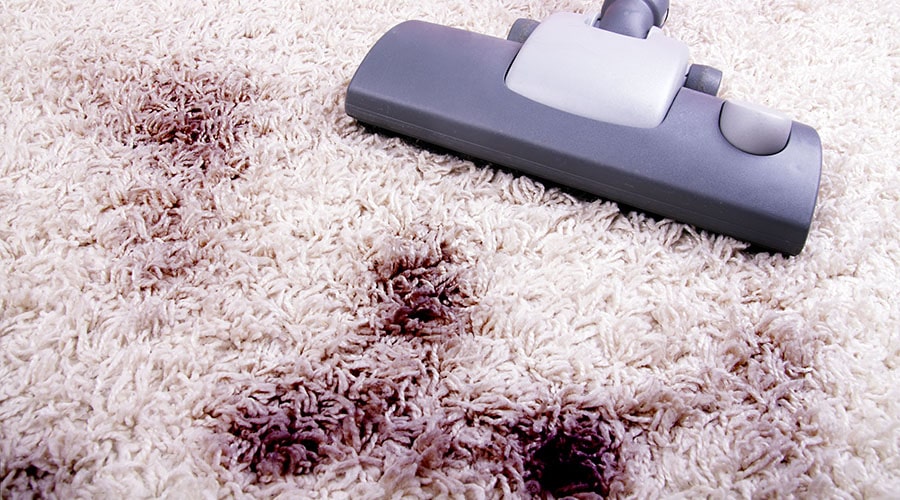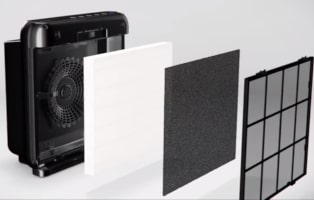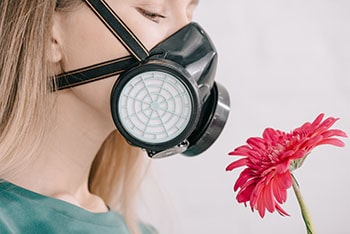Learn how to test your indoor air quality to save time and money on air treatment.
Indoor air can be up to 5X more polluted than outdoor air. An air purifier can certainly tackle some of the obvious troublemakers such as pollen and dust. But you’re only scratching the surface of the problem if you don’t identify exactly what may be lurking in the air you breathe.
Air quality can be affected by many different pollutants that many air purifiers can’t handle. Plus, pollutants will vary a lot depending on where you live and how you do life.

Pet owners, for instance, will likely have a lot more hair and pet dander to deal with than non-pet owners. Those in the midwest will be plagued with pollen. People in humid climates may be at risk for mold. Smokers will have pollutants from tobacco to deal with.
You get the drift.
To save yourself some time and money, and maybe even doctor bills, It’s wise to identify what’s muddling your air before you attempt to cleanse it.
Ways to test air quality
Air quality tests can be done either by a professional or yourself. The advantage of DIY testing is price, but you’ll be sacrificing some accuracy. It’s kind of like at-home colon cancer tests or breast self-exams. These can alert you to potential problems. For a really accurate diagnosis, however, following up with a doctor for more extensive and sensitive testing is necessary.
Think of your DIY air quality tests as a preliminary screening. If you find anything off, particularly if it’s way off the charts, bringing in a professional for further testing should be your next step.
For mild to moderate cases, you could get by with DIY tests, then DIY treatment, but that’s totally dependent on the situation and particular pollutant(s) involved.

Know what to test for
There are 3 main types of pollutants that can affect your air quality.
- Biological – Things derived from other living things like pollen, dust mites, mold, etc.
- Chemical – Includes VOCs (volatile organic compounds) that often have no physical indication or cause immediate symptoms. Ex: formaldehyde, lead, radon
- Combustion – Carbon monoxide is a biggie in this category, but also tobacco smoke and any byproduct of something burning
Let’s break them down in terms of specific ways to identify these things and what to do about it once you find them.
Biological air pollutants
- Mold – People sensitive to mold may have nasal congestion, sore throat, coughing, eye irritation, and asthma attacks. Even healthy people can experience respiratory symptoms if there’s enough mold in the environment.
The first method to test for mold is to follow your nose. If you smell any musty air, you’ve got mold somewhere. There, no further test needed. Just find the source and do what it takes to remove the problem. This may require a simple bleach scrub or more drastic measures such as replacing walls, tile, or carpet.
Then take measures to prevent regrowth such as a dehumidifier, improved air flow, fixing any water leaks, weatherizing, etc.

- Dust mites – It’s icky to think about how many of these microscopic critters can live in your home. A full 80% of allergy sufferers are sensitive to them. The weight of an average mattress can actually double in 10 years from dust mites alone.
They feast on dead skin cells that we shed constantly, so there will ALWAYS be dust mites around. Therefore specifically testing for them isn’t really necessary. Just assume they’re your constant companions.
Before you go Chernobyl with bug bombs (which won’t help), practice these preventative measures to decrease their numbers so you breathe a little easier.
- Keep the humidity at or below 50% since dust mites love warm and humid places.
- Cover mattresses and pillows with allergen-blocking covers. It will keep the dust mites from getting into your pillows and mattresses, so you can easily wash them away.
- Wash all your bedding in HOT water (140 degrees F, 60 degrees C) if possible. If you have a bedspread or something that can’t be washed easily, throw it in a freezer overnight.
- Replace bed pillows every 6 months.
- Vacuum and dust thoroughly and often.
- Pollen – Weeds, grasses, trees, and flowers. They all release pollen depending on the time of year and geographical location. Pollen gets in through open windows and doors and by sticking to people and pets, who then carry it inside.

Anyone with allergies knows pollen can cause the common symptoms known as hay fever. If you experience symptoms right about the time everything starts blooming, you’ll know pollen is to blame. Finding out which pollen is the culprit is a little harder.
One good way to find out which pollen you’re sensitive to is to visit an allergist for a skin patch test. This involves exposing your skin to 20 – 30 common allergens (including foods, animals, etc.) and measuring the dermal response.
Once you have an answer, you can work on combating the effects with medications during peak bloom seasons. Vacuum and dust regularly. Remove or avoid specific grasses, trees, or flowers. Keep windows closed. Use a clothes dryer instead of line-drying. Wash bedding weekly. Change HVAC filters often.
Chemical air pollutants
- VOCs – Volatile organic compounds are everywhere. Common VOC compounds include: benzene, formaldehyde, methylene chloride, etc. These are carbon-based particles released into the air via paints, cleaners, disinfectants, fuel, and even dry-cleaned clothes. Building materials, carpet and other furnishings can also release them.
Long-term exposure to some VOCs can cause damage to internal organs and the nervous system. Short-term symptoms usually involve eye irritation, headaches, coughing, dizziness, fatigue, skin rashes, nausea, etc.
The best way to combat their effects is with adequate fresh air ventilation any time you’re using paints or other VOC-releasing substances. Follow all precautions on labels. Properly discard old, unused chemicals. Avoid exposure to any chemical substance as much as possible, and store them all tightly sealed and away from your common living areas.

- Lead – We don’t often think of lead as being airborne, but it can be. Any painted surface before 1978 is likely to contain lead. It’s only a problem, however, when paint is deteriorating or improperly removed through scraping, sanding, or burning.
Lead exposure can affect all systems in the body. High levels can cause convulsions, coma and death. Lower levels can harm the central nervous system, blood and kidneys. It can cause developmental delays in children.
If you have a home or any object that was painted prior to 1978, it’s imperative to take precautions to reduce exposure. Regular dusting and washing of floors and surfaces, especially those that children come in contact with, is essential.
Lead paint should only be removed by professionals. If you work with lead-based anything outside the home, change your clothes before you go in the house and wash them separately.
- Radon – It’s the 2nd leading cause of lung cancer in the US. This colorless, odorless gas is a highly radioactive element released from the breakdown of uranium underground. Pretty much every state in the US has elevated radon levels.
It usually takes years to see any effects from radon in the form of lung cancer, so you can’t tell how much may be in your home from short term symptoms or any other signs. The only option is using short-term or long-term test kits to measure your home’s average radon level.
If you find a level of 4 picocuries per liter (pCi/L) or more, it’s time to consult a radon mitigation specialist to help you fix the problem.
Combustion air pollutants

- Secondhand smoke – From anything that burns tobacco, as well as what a smoker exhales. Tobacco smoke contains over 4,000 compounds, and at least 40 of those are carcinogens. Besides the risk of lung cancer for anyone breathing it, secondhand smoke increases the risk of respiratory infections, especially in infants and children. For kids or anyone with asthma, it can be particularly harmful.
Detection is easy enough. Tobacco smoke is easily seen and smelled. It seeps into fabrics, hair, and furniture. The yellow residue can cling to windows and mirrors.
Prevention is fairly simple. Don’t smoke in your house or allow anyone else to smoke inside. If you live in an apartment complex or other situation where a neighbor’s smoke comes in your home, you’ll need to find ways to seal up air leaks. Investing in a good air purifier placed near the source of entry is another solution.
- Carbon monoxide – This gas, in high concentrations, can cause unconsciousness or death. Low concentrations lead to headache, dizziness, nausea, fatigue, weakness, and confusion. It’s so dangerous because it’s colorless and odorless.
CO is emitted mostly by things that burn fossil fuels: stoves, fireplaces, kerosene heaters, gas-powered generators, cars, etc. Prevention lies in keeping flues and chimneys clear of blockages and never running gas-powered vehicles or machines indoors. However, some indoor gas appliances can malfunction and emit dangerous levels of CO.
That’s why every home should have a carbon monoxide detector with an alarm on every level of the house. Plus, you should install one near the entrance to any attached garage.
DIY Testing Tools
There are several devices and other home test kits you can use to measure air quality. All it really takes is a quick Google search. There are specific home tests for dust mites, mold, formaldehyde, lead, and more. But here are some notable smart tech devices that won’t cost you an arm and a leg.

- Foobot – The next generation of these air quality monitors arrives mid-September, 2019. This device measures VOCs, temperature, humidity, particulate matter, and CO2. It syncs to computers and smart devices with an app and takes about 6 days to fully calibrate.
- Speck – For measuring allergens such as dust, smoke, pollen, etc. and compares indoor to outdoor air quality readings. Also syncs to your phone or computer. New models arriving in 2023, but in some states, Speck has a library program where you can check out one of these devices from your local library just like a book.
- High-tech air purifiers – We’ve reviewed some of the best air purifiers on the market. Several of these have air quality monitors built into them and can automatically adjust their fan speeds to provide the level of filtration needed. Some are also specifically geared toward certain pollutants so you can find the one that most meets your air quality needs.

Air Purifier Tips & Tricks





Thanks for sharing such helpful content!
Hello Phil,
Thank you for the summary, this is very helpful. However, I have one question – why do you recommend the Speck analyzer rather than the PurpleAir II? In the field studies and the lab testing by South Coast AQMD the Speck has shown to be completely unreliable (underestimating by about 60%) while the Purple did perform well in comparison to the reference instruments – yes the Purple costs $250 rather than $150, but its still within a reasonable price range… Please advice.
Thank you for your blog, It helped me a lot in improving my home air quality. I followed your steps and seen a great change in air quality in my house. Although the air quality in my area is very bad, looking for air quality test for my area so as to improve it.